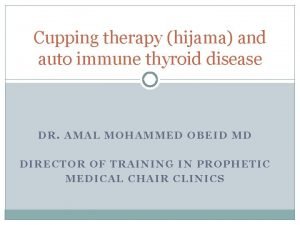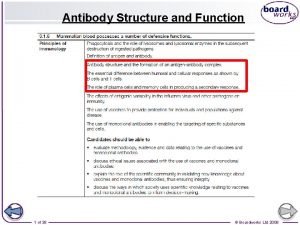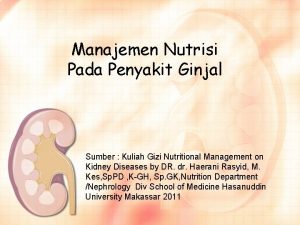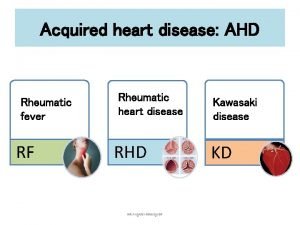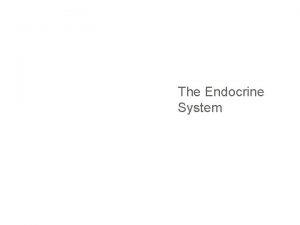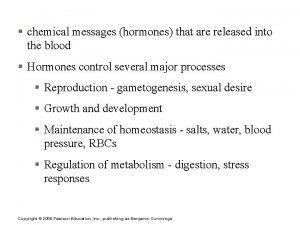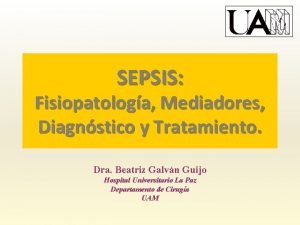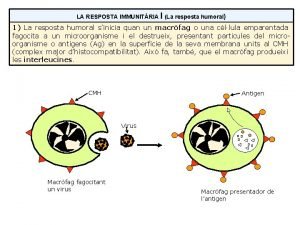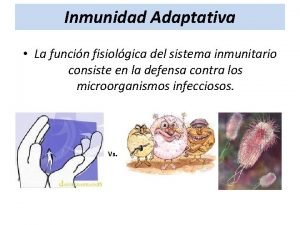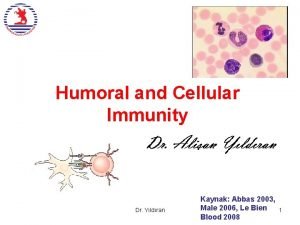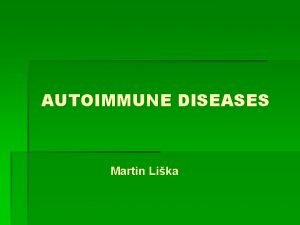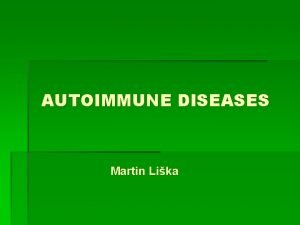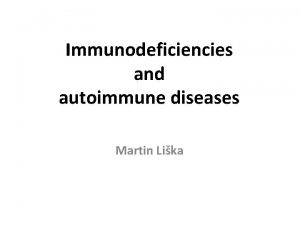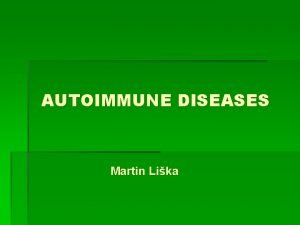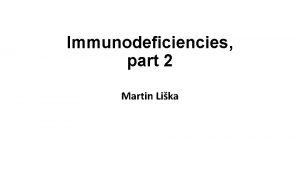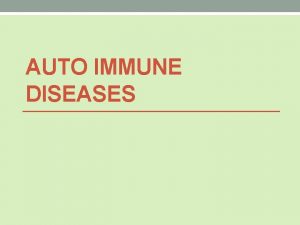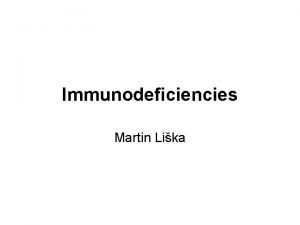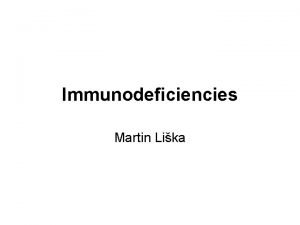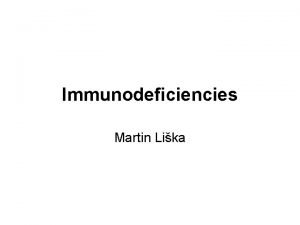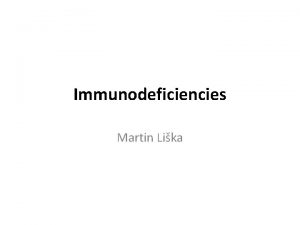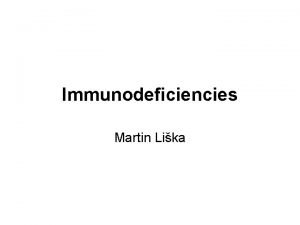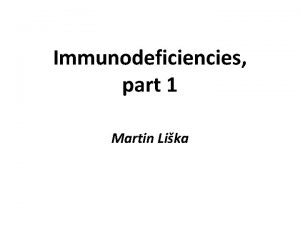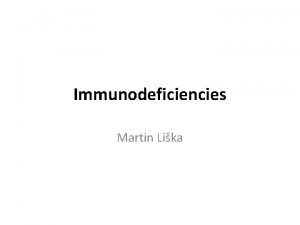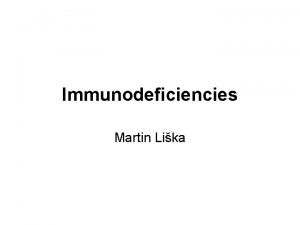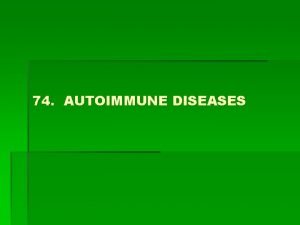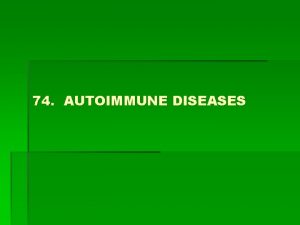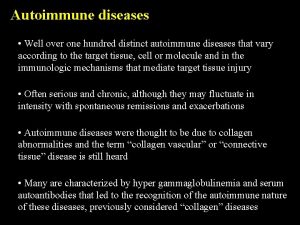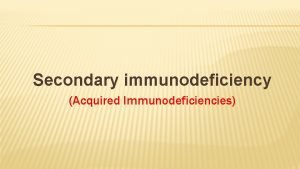Immunodeficiencies and autoimmune diseases Martin Lika Immunodeficiencies Humoral












































- Slides: 44

Immunodeficiencies and autoimmune diseases Martin Liška

Immunodeficiencies • Humoral – innate immunity - complement, MBL acquired immunity – immunoglobulins (B lymphocytes) • Cell mediated immunity – innate immunity – phagocytes - acquired immunity – T lymphocytes • Primary – congenital, genetically defined, symptoms predominantly at early age • Secondary – the onset of symptoms at any age chronic diseases effect of irradiation immunosuppression surgical intervention, injuries stress

Immunodeficiencies – critical life periods in respect to symptoms onset • Newborn age - severe primary disorders of cell mediated immunity • 6 mth. – 2 yrs. – severe humoral immunodeficiencies cong. /transient • 3 - 5 yrs. – transient and selective humoral immunodeficiencies, secondary immunodeficiencies • 15 – 20 yrs. – hormonal instability, thymus involution, life-style changes, some typical infections first symptoms of CVID • Middleage – often excessive workload, stress first symptoms of autoimmune disorders (also immunodeficiency) • Advanced and old age – rather symptoms of severe secondary immunodeficiencies, repercussion of functional disorders

Immunodeficiencies – major clinical features • Antibodies - microbial infections (encapsulated bacteria) respiratory - pneumonia, sinusitis, otitis GIT – diarrhea • Complement system – microbial infections (pyogenic), sepsis edema (HAE) – C 1 -INH deficiency • T lymphocytes - bacterial, fungal, viral GIT – diarrhoea respiratory – pneumonia, sinusitis • Phagocytes - abscesses, recurrent purulent skin infections granulomatous inflammation

I. Primary immunodeficiencies – phagocytic cell defects 1/ Quantitative – decreased numbers of granulocytes – neutrophil elastase mutation Congenital chronic agranulocytosis Cyclic agranulocytosis (neutropenia)

I. Primary immunodeficiencies – phagocytic cell defects 2/ Qualitative – phagocytes functional disorders, various enzyme deficits, inability of phagocytes to degrade the ingested material a/ Chronic Granulomatous Disease (CGD) • Approximately in 60% X-linked • Enzymatic inability to generate toxic oxygen metabolites (H 2 O 2) during oxygen consumption) - result of defect in neutrophilic cytochrome b (part of complex containing NADPH oxidase) • Inability to kill bacteria such as Staph. aureus, Pseud. aeruginosa that produce catalase • Clinical features: granulomas of skin, organs • Treatment: long-term ATB administration

II. Primary immunodeficiencies – B cell disorders • Bruton’s X-linked hypogamaglobulinemia Blockage of the maturation of pre-B lymphocytes into B lymphocytes (tyrosine kinase defect) Undetectable or very low serum levels of Ig Pneumonia, pyogenic otitis, complicated sinusitis, increased occurrence of pulmonary fibrosis Treatment: life-long IVIG substitution • • CVID – Common Variable Immuno. Deficiency B cell functional disorder, mostly low levels of Ig. G and Ig. A Symptoms’ onset between 2 nd and 3 rd decade Recurrent respiratory tract infections (pneumonia) Treatment: IVIG substitution • • •

II. Primary immunodeficiencies – B cell disorders Selective Ig. A deficiency • Disorder of B cell function • Recurrent mild/moderate infections (respiratory, GIT, urinary tract) or asymptomatic • Risk of reaction to live attenuated vaccines or generation of anti-Ig. A antibodies after a blood transfusion Selective Ig. G subclasses or specific Ig. G deficiency • B cell function disorder • Onset of symptoms in childhood, mostly respiratory tract infections caused by encapsulated bacteria (H. influenzae, Pneumococci) Transient hypogammaglobulinemia of infancy

III. Primary immunodeficiencies – T cell disorders di. George syndrome • Disorder of prethymocytes maturation due to absence of thymus (disorder of development of 3 rd and 4 th branchial pouch) • Congenital heart diseases • The onset of symptoms after the birth – hypocalcemic spasms and manifestations of cong. heart disease • Immunodeficiency could be only mild, the numbers of T lymphocytes later usually become normal • Treatment symptomatic

IV. Primary immunodeficiencies – combined defects of T and B cells SCID – Severe Combined Immuno. Deficiency • X-linked recessive or AR disease, combined disorder of humoral and cell mediated immunity • Severe disorder (patients often die during first 2 years of life), onset of symptoms soon after birth (severe diarrhoea, pneumonia, meningitis, BCGitis) • Immunological features: typically lymphopenia and thymus hypoplasia • Forms: AR form – often enzymatic deficiency (ADA, PNP) that leads to accumulation of metabolites toxic to DNA synthesis (lymphocytes) X-linked form – disorder of stem-cell Treatment: ATB, IVIG BMT is of critical significance gene therapy

V. Primary immunodeficiencies – complement system disorders Hereditary angioedema (HAE) • Absence or functional deficiency of C 1 -inhibitor • Anaphylactoid reactions with skin and/or mucosal (oral, laryngeal, gut) edemas caused by activation of kinin system • Injuries or surgical/stomatological interventions are mostly triggering factor • Laryngeal edemas could be life-threatening, immediate treatment is necessary ! • Treatment: preventive – androgens, EACA immediate – C 1 -INH concentrate or fresh frozen plasma administration - newly bradykinin receptor antagonist (icatibant)

Secondary immunodeficiencies • Acute and chronic viral infections – infectious mononucleosis, influenza • Metabolic disorders – diabetes mellitus, uremia • Autoimmune diseases – autoantibodies against immunocompetent cells (neutrophils, lymphocytes); autoimmune phenomena also after administration of certain drugs (e. g. oxacilin, quinidine) • Chronic GIT diseases • Malignant diseases (leukemia) • Hypersplenism/asplenia • Burn, postoperative status, injuries • Severe nutritional disorders • Chronic infections • Ionizing radiation • Drug induced immunodeficiencies (chemotherapy) • Immunosupressive therapy • Chronic stress • Chronic exposure to harmful chemical substances

Secondary immunodeficiencies - A. I. D. S. • Caused by retrovirus HIV 1 or HIV 2 • Virus has a tropism for cells bearing CD 4 surface marker (Th CD 4+ lymphocytes); also affects macrophages and CNS cells • Viral genome transcribes into human DNA and infected cell provides viral replication • Transmission: sexual intercourse contact with blood endouterine (mother – fetus, breast milk) • Phases: acute (flu-like sy) asymptomatic – several years, viral replication symptomatic – infections, autoimmune disorders, malignancy, allergy final – systemic breakdown, opportune infections

A. I. D. S. - Treatment • • Reverse transcriptase inhibitors (e. g. zidovudine) Protease inhibitors - block the viral protease enzyme Combined drug therapy Antimicrobial agents

AUTOIMMUNE DISEASES

Autoimmune disease • Results from a failure of self-tolerance • Immunological tolerance is specific unresponsiveness to an antigen • All individuals are tolerant of their own (self) antigens

AUTOIMMUNE PATOLOGICAL RESPONSEETIOLOGY • the diseases are chronic and usually irreversible • incidence: 5%-7% of population, higher frequencies in women, increases with age • factors contribute to autoimmunity: - internal (HLA association, polymorphism of cytokine genes, defect in genes regulating apoptosis, polymorphism in genes for TCR a H immunoglobulin chains, association with immunodeficiency, hormonal factors) - external (infection, stress by activation of neuroendocrine axis and hormonal dysbalance, drug and ionization through modification of autoantigens)

CLINICAL CATEGORIES • systemic - affect many organs and tissue • organoleptic - affect predominantly one organ accompanied by affection of other organs (inflammatory bowel diseases, celiac disease, AI hepatitis, pulmonary fibrosis) • organ specific - affect one organ or group of organs connected with development or function

SYSTEMIC AUTOIMMUNE DISEASES • • Systemic lupus erythematosus Rheumathoid arthritis Sjögren‘s syndrome Dermatopolymyositis Systemic sclerosis Mixed connective tissue disease Vasculitis

SYSTEMIC LUPUS ERYTHEMATOSUS • chronic, inflammatory, multiorgan disorder • autoantibodies react with nuclear material and attack cell function, immune complexes with ds. DNA deposit in the tissue • general symptoms: include malaise, fever, weight loss • multiple tissue are involved including the skin, mucosa, kidney, joints, brain and cardiovascular system • characteristic features: butterfly rash, renal involvement, CNS manifestation, pulmonary fibrosis

DIAGNOSTIC TESTS • a elevated ESR (erythrocyte sedimentation rate), low CRP, trombocytopenia, leucopenia, hemolytic anemia, decreased levels of complement compounds (C 4, C 3), elevated serum Ig levels, immune complexes in serum

AUTOANTIBODIES • Autoantibodies: ANA, ds. DNA (double-stranded), ENA (SS-A/Ro, SS-A/La), Sm, against histones, phospholipids

RHEUMATOID ARTHRITIS • chronic, inflammatory disease with systemic involvement • characterized by an inflammatory joint lesion in the synovial membrane, destruction of the cartilage and bone, results in the joint deformation • clinical features: arthritis, fever, fatigue, weakness, weight loss • systemic features: vasculitis, pericarditis, uveitis, nodules under skin, intersticial pulmonary fibrosis • diagnostic tests: elevated C- reactive protein and ESR, elevated serum gammaglobulin levels - autoantibodies against Ig. G = rheumatoid factor (RF), a-CCP (cyclic citrulline peptid), ANA - X-rays of hands and legs- show a periarticular porosis, marginal erosion

SJÖGREN‘S SYNDROME • • chronic inflammatory disease affecting exocrine glands the primary targets are the lacrimal and salivary gland duct epithelium general features: malaise, weakness, fever primary syndrome - features: dry eyes and dry mouth, swollen salivary glands, dryness of the nose, larynx, bronchi and vaginal mucosa, involvement kidney, central and periferal nervous system, arthritis • secondary syndrome – is associated with others AI diseases (SLE, RA, sclerodermia, polymyositis, primary biliary cirhosis, AI thyroiditis) • autoantibodies against ENA (SS-A, SS-B), ANA, RF • The Schirmer test - measures the production of tears

Dermatopolymyositis • a connective-tissue disease related to polymyositis (PM) that is characterized by inflammation of the muscles and the skin. Gottron's sign is an Heliotrope rash is a violaceous erythematous, scaly eruption on the upper eyelids, occurring in symmetric fashion often with swelling over the MCP and interphalangeal joints

Dermatopolymyositis • Elevated creatine phosphokinase (CPK) • muscle biopsy (a mixed B- and T-cell perivascular inflammatory infiltrate, perifascicular muscle fiber atrophy) • EMG (electromyogram) • autoantibodies - ENA (Jo-1)

Systemic sclerosis • sclerosis in the skin or other organs • Diffuse scleroderma (progressive systemic sclerosis) is the most severe form, involves skin, will generally cause internal organ damage (specifically the lungs and gastrointestinal tract) • The limited form is much milder • The limited form is often referred to as CREST syndrome (CREST is an acronym for the five main features: Calcinosis, Raynaud's syndrome, Esophageal dysmotility, Sclerodactyly, Telangiectasia

Immunological findings • ANA, ENA - anti-Scl-70 (fluorescence of nucleolus), anti-centromers

Mixed connective tissue disease • combines features of polymyositis, systemic lupus erythematosus, scleroderma, and dermatomyositis (overlap syndrome) • Symptoms : joint pain/swelling, malaise, Raynaud phenomenon, muscle inflammation and sclerodactyly (thickening of the skin of the pads of the fingers) • Distinguishing laboratory characteristics: a positive, speckled anti-nuclear antibody (ANA) and anti-U 1 -RNP antibody (ENA)

Vasculitis • characterized by inflammatory destruction of vessels leading to thrombosis and aneurysms • proliferation of the intimal part of blood-vessel wall and fibrinoid necrosis • affect mostly lung, kidneys, skin • diagnostic tests: elevated ESR, CRP, leucocytosis, biopsy of affected organ (necrosis, granulomas), angiography

Vasculitis • p- ANCA (myeloperoxidase) positivity (Polyarteritis nodosa, Churg- Strauss, Microscopic polyarteritis nodosa) • c- ANCA (serin proteinase) positive (Wegener granulomatosis, Churg- Strauss syndrome)

Classification • Large vessel vasculitis (Takayasu arteritis, Giant cell (temporal) arteritis) • Medium vessel vasculitis (Polyarteritis nodosa, Wegener's granulomatosis, Kawasaki disease) • Small vessel vasculitis (Churg-Strauss arteritis, Microscopic polyarteritis, Henoch-Schönlein purpura) • Symptoms: fatigue, weakness, fever, arthralgias, abdominal pain, hypertension, renal insufficiency, and neurologic dysfunction

ORGANOLEPTIC AUTOIMMUNE DISEASES • • • Ulcerative colitis Crohn‘s disease Autoimmune hepatitis Primary biliary cirhosis Pulmonary fibrosis

Ulcerative colitis • chronic inflammation of the large intestine mucosa and submucosa • features: diarrhea, bloody and mucus stools • extraintestinal features (arthritis, uveitis) • Autoantibodies: p. ANCA, a- large intestine

Crohn‘s disease • the granulomatous inflammation of whole intestinal wall with ulceration and scarring that can result in abscess and fistula formation • the inflammation of Crohn's disease the most commonly affects the terminal ileum, presents with diarrhea and is accompanied by extraintestinal features - iridocyclitis, uveitis, artritis, spondylitis • antibodies against Saccharomyces cerevisiae (ASCA), a- pancreas

AUTOIMMUNE HEPATITIS • type I – association with autoantibodies against smooth muscles SMA, ANCA, SLA • type II – autoantibodies against microsomes LKM-1 = liver-kidney microsomes • type III – autoantibodies against SLA (solubile liver antigen) • type IV – overlap syndrome with PBC – autoantibodies against mitochondries AMA

AUTOIMMUNE ENDOCRINOPATHY • • • Hashimoto‘s thyroiditis Graves-Basedow disease Diabetes mellitus I. type Addison‘s disease Autoimmune polyglandular syndrome

Hashimoto‘s thyroiditis • thyroid disease result to hypothyroidism on the base of lymphocytes and plasma cells infiltrate • autoantibodies against thyroidal peroxidase (a-TPO) and/or against thyroglobulinu (a-TG)

Grave‘s disease • thyrotoxicosis from overproduction of thyroid hormone (patient exhibit fatigue, nervousness, increased sweating, palpitations, weight loss, exophtalmus) • autoantibodies against thyrotropin receptor, autoantibodies cause thyroid cells proliferation

Diabetes mellitus (insulin- dependent) • characterized by an inability to process sugars in the diet, due to a decrease in or total absence of insulin production • results from immunologic destruction of the insulineproducing β-cells of the islets of Langerhans in the pancreas • autoantibodies against GAD (glutamic acid decarboxylase = primary antigen), autoantibodies anti- islet cell, anti- insulin • islets are infiltrated with B and T cells

AUTOIMMUNE NEUROPATHY • Guillain-Barré syndrome (acute idiopathic polyneuritis) • Myasthenia gravis • Multiple sclerosis

Multiple sclerosis • chronic demyelinizing disease with abnormal reaction T cells to myeline protein on the base of mimicry between a virus and myeline protein • features: weakness, ataxia, impaired vision, urinary bladder dysfunction, paresthesias, mental abberations • autoantibodies against MOG (myelin-oligodendrocyte glycoprotein) • Magnetic resonance imaging of the brain and spine shows areas of demyelination • The cerebrospinal fluid is tested for oligoclonal bands, can provide evidence of chronic inflammation of the central nervous system

AUTOIMMUNE CYTOPENIA • AI hemolytic disease- autoantibodies against membrane erythrocyte antigens • AI trombocytopenia - autoantibodies against trombocyte antigens (GPIIb/IIIa) • AI neutropenia - autoantibodies against membrane neutrofil antigens

Treatment of autoimmune diseases Systemic AI – non-specific immunosuppression: glucocorticoids cytostatics: • alkylating agents cyclophosphamide • purine analogs - azathioprine, mycophenolate, • antimetabolites - metotrexate • antibiotics - cyclosporin A, tacrolimus • monoclonal antibodies Organ specific AI non-specific immunosuppression Endocrinopathies Substitution of lacking product of endocrinal gland destroyed by AI process -insulin, thyroid gland hormones
 Cupping and autoimmune disease
Cupping and autoimmune disease Endocrine system pearson
Endocrine system pearson Humoral and cell mediated immunity difference
Humoral and cell mediated immunity difference Autoimmune diet
Autoimmune diet Crohn's disease symptoms
Crohn's disease symptoms Ahd heart
Ahd heart Stimulus humoral
Stimulus humoral Humoral stimulus
Humoral stimulus Effector mechanism of humoral immunity
Effector mechanism of humoral immunity La respuesta
La respuesta Reactantes de fase aguda
Reactantes de fase aguda Receptores celulares
Receptores celulares Humoral patoloji paradigması
Humoral patoloji paradigması Limfoblast
Limfoblast Antigenos virales
Antigenos virales Abbas
Abbas Ibali lika nongqawuse
Ibali lika nongqawuse Hrvatska spisateljica
Hrvatska spisateljica Kiklop kratki sadrzaj
Kiklop kratki sadrzaj Filip i kyriales
Filip i kyriales Površina jednakokračnog trokuta
Površina jednakokračnog trokuta Opseg lika
Opseg lika Taktika darba laiks
Taktika darba laiks Baraka pet be simbolika
Baraka pet be simbolika Gorski kotar lika
Gorski kotar lika Djevojčica sa šibicama crtani film na hrvatskom
Djevojčica sa šibicama crtani film na hrvatskom Tijek radnje dnevnik pauline p
Tijek radnje dnevnik pauline p Lika syndrome
Lika syndrome Galeb jonathan livingston kviz
Galeb jonathan livingston kviz Načelo lika in podlage
Načelo lika in podlage Miro gavran judita
Miro gavran judita Arber lika
Arber lika U registraturi
U registraturi Simetrala likov
Simetrala likov Epika u prozi
Epika u prozi Književnost 5 razred
Književnost 5 razred Tacrolimus
Tacrolimus Lifestyle modern
Lifestyle modern Is athlete's foot communicable or noncommunicable
Is athlete's foot communicable or noncommunicable Section 19-3 diseases caused by bacteria and viruses
Section 19-3 diseases caused by bacteria and viruses Retention hyperkeratosis dermnet
Retention hyperkeratosis dermnet Chapter 6 musculoskeletal system
Chapter 6 musculoskeletal system Chapter 24 sexually transmitted diseases and hiv/aids
Chapter 24 sexually transmitted diseases and hiv/aids Chapter 22 genetics and genetically linked diseases
Chapter 22 genetics and genetically linked diseases Chapter 21 mental health diseases and disorders
Chapter 21 mental health diseases and disorders
